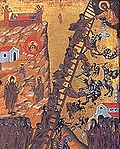
Summary: St John of the ladder, monk, abbot of Mt Sinai
John was a 7th century Christian monk on Mount Sinai. His nick-name (“of the Ladder”, Greek τῆς Κλίμακος, Latin Climacus) comes from his classic spiritual work in ascetical literature which he wrote entitled ‘The Ladder of Paradise or The Ladder of Divine Ascent.’
 As the image below implies, the “ladder” by which one reached Paradise had 30 rungs – or difficult stages – one had to deal with and at every stage there would be a devil ready and willing to pull you down, especially if you were in any way complacent or presumptuous. The Ladder of Paradise is read in Orthodox monasteries during Lent.
As the image below implies, the “ladder” by which one reached Paradise had 30 rungs – or difficult stages – one had to deal with and at every stage there would be a devil ready and willing to pull you down, especially if you were in any way complacent or presumptuous. The Ladder of Paradise is read in Orthodox monasteries during Lent.
Patrick Duffy researches what is known of John’s life and work.
Early Life
Little is known for definite about John’s early life. He was born in Palestine. Some say that he became a monk on Mt Sinai at the age of sixteen and afterwards lived as a solitary in different places in the Arabian Desert. Others say he was married in early life and became a monk on the death of his wife and that after some years in community, he then became a hermit, coming together with other hermits to church only on Saturday and Sunday.
Abbot of Mt Sinai
John was already seventy when he was made abbot of Sinai, and four years later he resigned to prepare in solitude for his death.
The Ladder to Paradise
John’s fame comes mainly from a work he wrote that was much read in East and West entitled The Ladder to Paradise. This work treats of the way to union with God and moral perfection to be reached by a ladder of the following thirty “rungs” into which the book is divided:

The Ladder as Inspiration and Emblem
The idea of the spiritual life as a ladder has inspired artists to develop interesting illustrations to motivate those on the spiritual journey and as an emblem of the saint himself. His feast is on 30th March.
____________________________
******************************
Memorable Saying for Today
A Holy man is a mighty weapon in the hands of God
~ Robert Murry M’Cheyne ~
******************************